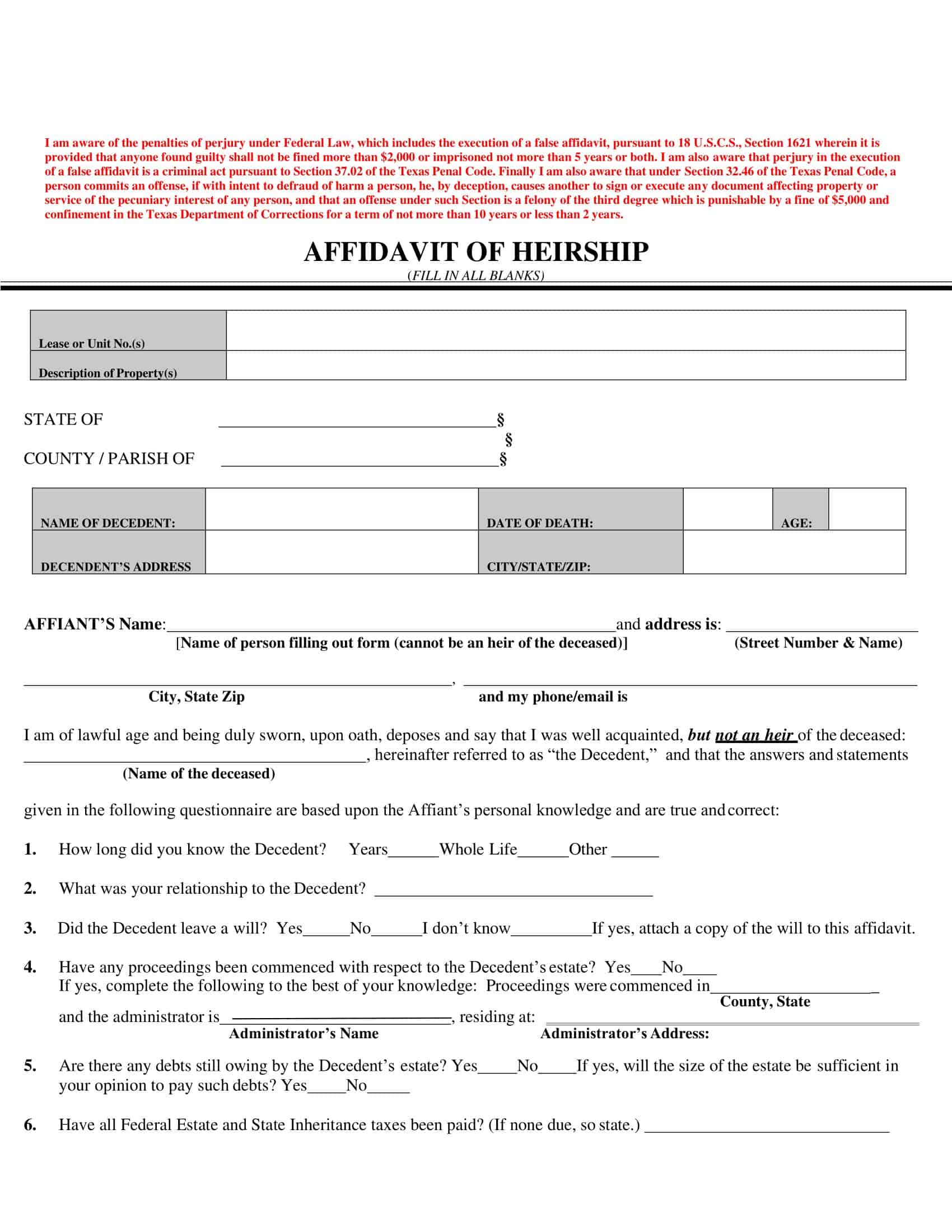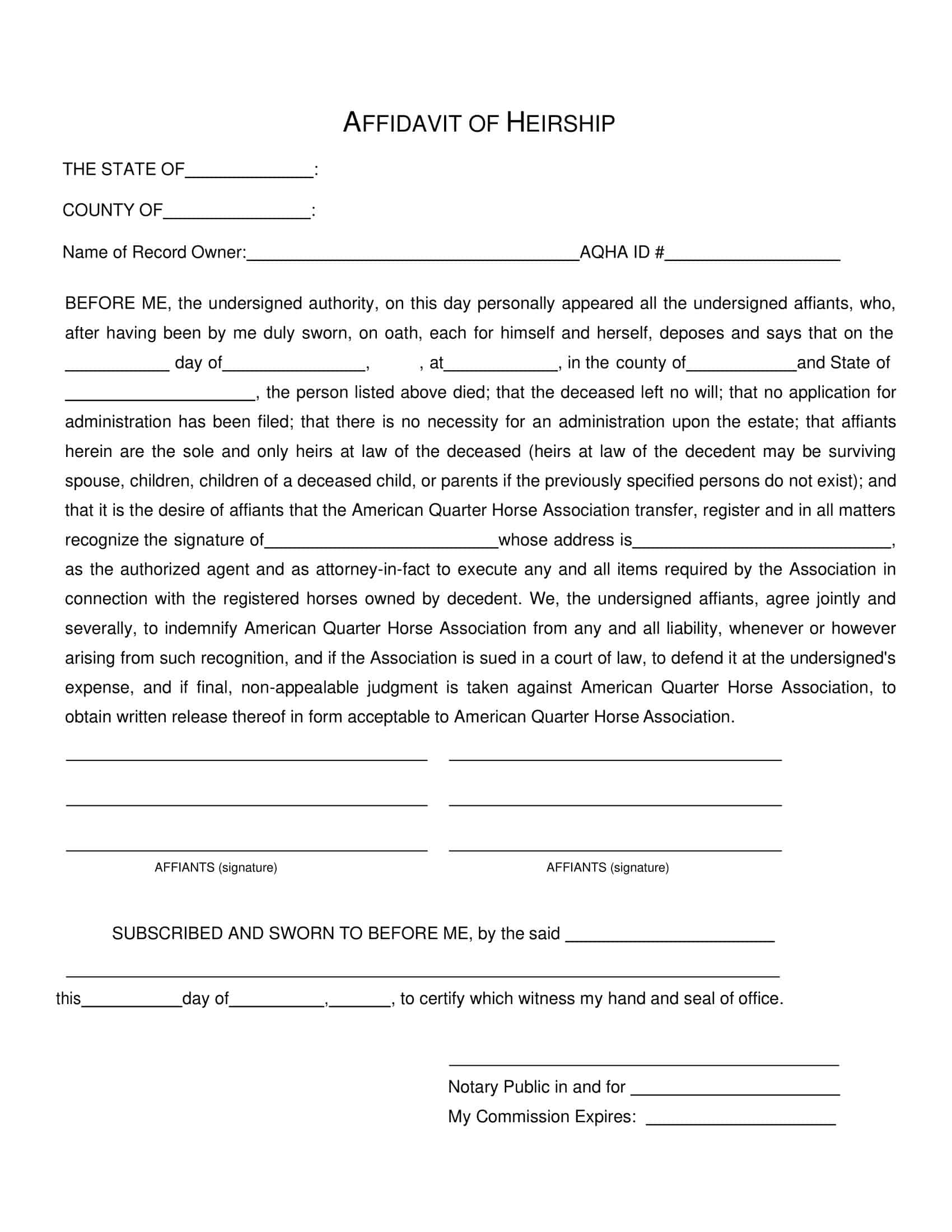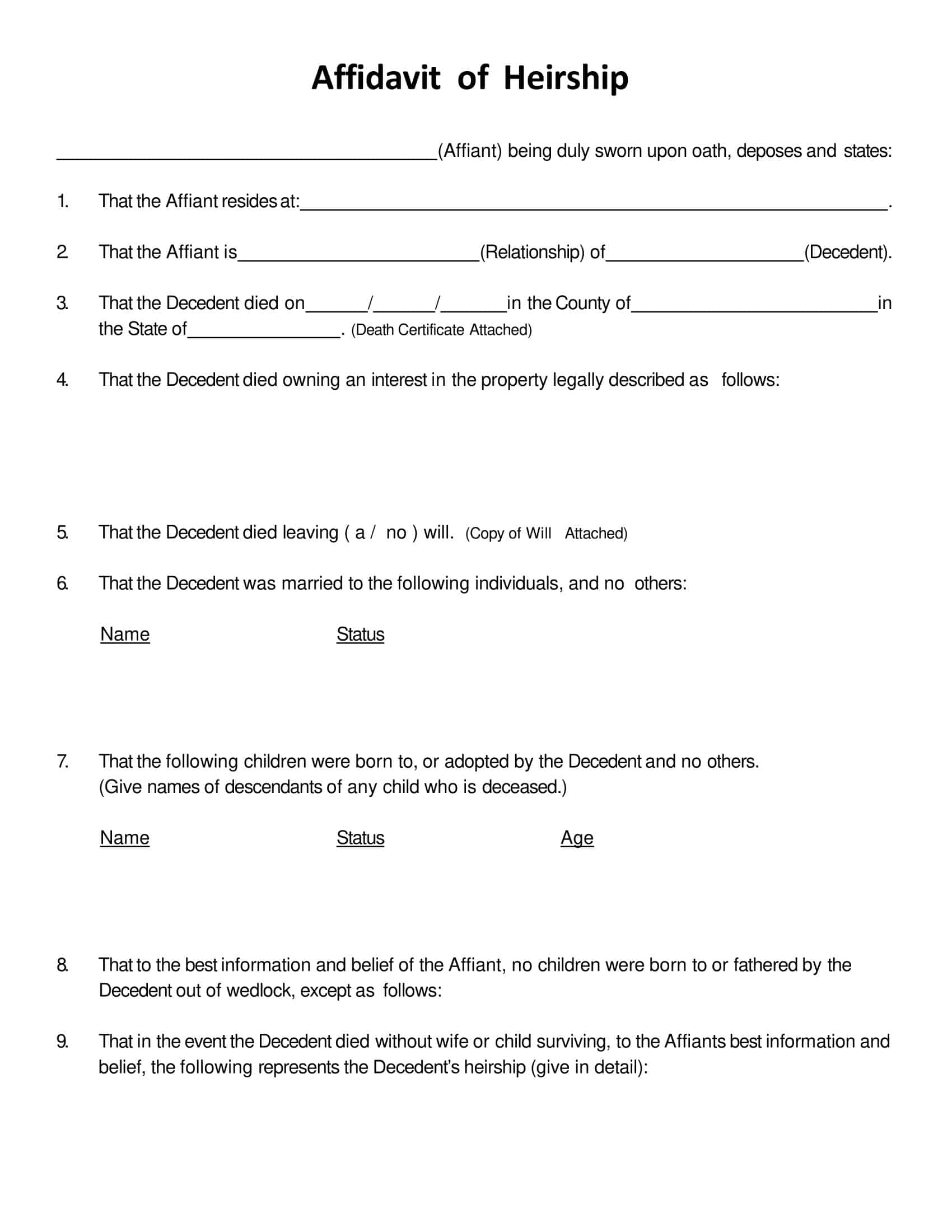An Affidavit of Heirship is a legal document that is used to establish the heirs of an individual who has passed away without leaving a will. It is often used in probate proceedings when the deceased person’s assets need to be distributed to their heirs. The Affidavit of Heirship contains information about the deceased person’s family members, their relationships to the deceased, and other relevant details.
This document is important because it helps to establish the rightful heirs to the deceased person’s assets and provides a clear and concise record of the family relationships. It is a crucial tool in settling the estate of a loved one and ensuring that their assets are distributed in accordance with their wishes.
Table of Contents
Affidavit of Heirship Templates
An affidavit of heirship template is a pre-designed legal document that is used to establish the rightful heirs of a deceased person’s estate. This document provides a sworn statement, typically made by a family member or close associate, affirming the identity of the heirs and their relationship to the deceased.
Affidavit of heirship templates generally include sections for the name and personal details of the deceased individual, the names and contact information of the heirs, a description of their relationship to the deceased, and any supporting documentation or evidence of the heirs’ claims.
Using an affidavit of heirship template can help simplify the process of establishing legal ownership and distribution of an estate. By providing a standardized format, the template ensures that all necessary information is included and that the document meets the requirements of the jurisdiction in which it is being used.
When is an affidavit of heirship used?

An Affidavit of Heirship is used when an individual has passed away without leaving a will and their assets need to be distributed to their heirs. This document is used in probate proceedings as evidence of the deceased person’s family relationships and can be used to determine who is entitled to receive the deceased person’s assets.
It is also commonly used when real property is involved, such as land or a home, and a clear chain of title is needed in order to transfer ownership to the heirs. The Affidavit of Heirship can be used to show that the deceased person’s assets have passed to their heirs and that the heirs have the right to sell, transfer, or otherwise dispose of the assets.
In situations where there is no will, the Affidavit of Heirship can provide a crucial piece of evidence in determining the rightful heirs to the deceased person’s assets, helping to ensure that their assets are distributed in an orderly and fair manner.
The Importance of an Affidavit of Heir
An Affidavit of Heirship is an important document in probate proceedings, as it helps to establish the rightful heirs to a deceased person’s assets. When a person passes away without a will, it can be difficult to determine who is entitled to receive their assets, leading to disputes and delays in the probate process. An Affidavit of Heirship provides clear and concise evidence of the deceased person’s family relationships, helping to establish who the rightful heirs are and streamlining the probate process.
In addition to simplifying the probate process, an Affidavit of Heirship can also save time and money, as it is usually a less expensive alternative to a formal probate court proceeding. By establishing the rightful heirs to the deceased person’s assets, the Affidavit of Heirship can help to avoid disputes and ensure that the assets are distributed in an orderly and fair manner.
In conclusion, an Affidavit of Heirship is an important document in probate proceedings, as it helps to establish the rightful heirs to a deceased person’s assets and streamline the probate process. Before using an Affidavit of Heirship, it is recommended to consult with an attorney to determine if it is the best option for your situation.
Advantages and Disadvantages of Affidavit of Heirship
Streamlined Probate Process: An Affidavit of Heirship can simplify the probate process by establishing the rightful heirs to the deceased person’s assets, reducing the need for a lengthy and complicated probate court proceeding.
Cost Effective: Preparing an Affidavit of Heirship is usually a less expensive alternative to a formal probate court proceeding.
Time-saving: An Affidavit of Heirship can be processed more quickly than a formal probate court proceeding, which can save time and reduce stress for the heirs.
Clear Record of Heirs: The Affidavit of Heirship provides a clear and concise record of the family relationships, helping to establish the rightful heirs to the deceased person’s assets.
Disadvantages of Affidavit of Heirship:
Limited Scope: An Affidavit of Heirship can only be used in situations where the deceased person did not leave a will.
Potential for Disputes: The Affidavit of Heirship may not resolve all disputes between the heirs, and additional legal proceedings may be necessary to resolve these disputes.
Limited Legal Standing: An Affidavit of Heirship is not a court-issued document, and it may not have the same legal standing as a court-ordered probate proceeding.
Required Documentation: To prepare an Affidavit of Heirship, the heirs must have access to the deceased person’s records and family history, which may not be available or easy to obtain.
In conclusion, an Affidavit of Heirship can be a useful tool in determining the rightful heirs to a deceased person’s assets and simplifying the probate process. However, it may not resolve all disputes between the heirs, and additional legal proceedings may be necessary to resolve these disputes. Before using an Affidavit of Heirship, it is recommended to consult with an attorney to determine if it is the best option for your situation.
What is a declaration of heirs?
A Declaration of Heirs is a document that lists the names and relationships of the individuals who are considered to be the rightful heirs to a deceased person’s assets. It is typically used in situations where the deceased person did not leave a will, and it is necessary to determine who is entitled to receive the deceased person’s assets.
A Declaration of Heirs is similar to an Affidavit of Heirship, and it is often used interchangeably with that term. Both documents serve as evidence of the family relationships and can be used to determine the rightful heirs to a deceased person’s assets.
The Declaration of Heirs typically contains information about the deceased person, including their name, date of birth, and date of death. It also includes information about the deceased person’s family members, such as their names, relationships to the deceased, and any other relevant details.
The Declaration of Heirs is an important document in probate proceedings, as it provides a clear and concise record of the family relationships and helps to establish the rightful heirs to the deceased person’s assets. However, it is important to keep in mind that the Declaration of Heirs is not a court-issued document and may not have the same legal standing as a court-ordered probate proceeding.
How does heirship work in Texas?
In Texas, the process of determining heirship is called a “determination of heirship.” When a person passes away without a will, their assets are distributed according to Texas state law. This process is governed by the Texas Probate Code and is typically handled in a probate court.
The following is a detailed guide on how heirship works in Texas:
Identifying the deceased person’s assets: The first step in determining heirship is to identify all of the deceased person’s assets, including real estate, personal property, and any financial accounts.
Notifying potential heirs: The next step is to notify all potential heirs of the deceased person’s passing. This can be done by publishing notice in a local newspaper or by mailing notice directly to the potential heirs.
Filing a petition for determination of heirship: Once the potential heirs have been notified, a petition for determination of heirship can be filed with the probate court. This petition must be signed by one or more of the potential heirs and must include information about the deceased person’s assets and the relationships of the potential heirs.
Review of evidence by the court: The court will review the petition and any other evidence that is submitted, such as birth certificates and marriage licenses, to determine the rightful heirs to the deceased person’s assets.
Court hearing: If necessary, the court may hold a hearing to gather additional information and hear from witnesses. The court may also appoint an attorney to represent any potential heirs who are minors or who are otherwise unable to represent themselves.
Court order: Once the court has determined the rightful heirs, a court order will be issued. This order will list the names of the rightful heirs and will provide instructions for distributing the deceased person’s assets.
Distribution of assets: After the court order is issued, the assets of the deceased person will be distributed to the rightful heirs according to the court’s instructions.
In conclusion, determining heirship in Texas is a complex process that is governed by state law and typically handled in a probate court. It is important to understand the process and to seek the help of an attorney if necessary.
FAQs
Who can file an Affidavit of Heirship?
An Affidavit of Heirship can be filed by any interested party, such as a family member of the deceased person, a creditor, or a representative of the deceased person’s estate. The person filing the Affidavit must have personal knowledge of the deceased person’s family relationships and must be able to provide evidence to support the information included in the Affidavit.
Can an Affidavit of Heirship be challenged?
Yes, an Affidavit of Heirship can be challenged by any interested party, such as a creditor or a potential heir. If the Affidavit is challenged, the person who filed it must be able to provide evidence to support the information included in the Affidavit.
Can an Affidavit of Heirship be used to transfer real estate?
Yes, an Affidavit of Heirship can be used to transfer real estate, but it may not be recognized by all government agencies or courts. In some cases, a more formal probate process may be required to transfer real estate.
Can an Affidavit of Heirship be used for inheritance purposes?
Yes, an Affidavit of Heirship can be used for inheritance purposes to establish the identity of the rightful heirs and distribute the deceased person’s assets according to state law.
How long does an Affidavit of Heirship remain valid?
The validity of an Affidavit of Heirship depends on the laws of the jurisdiction in which it was filed. In some cases, an Affidavit of Heirship may remain valid for a specified period of time, while in others, it may remain valid indefinitely.
Can an Affidavit of Heirship be used in all states?
No, an Affidavit of Heirship is governed by the laws of the jurisdiction in which it is filed, and may not be recognized or accepted by all states. Before using an Affidavit of Heirship, it is recommended to consult with an attorney to determine if it is the best option for your situation and if it will be recognized in the jurisdiction where you are located.


























































![Free Printable Roommate Agreement Templates [Word, PDF] 1 Roommate Agreement](https://www.typecalendar.com/wp-content/uploads/2023/06/Roommate-Agreement-150x150.jpg)
![Free Printable Credit Card Authorization Form Templates [PDF, Word, Excel] 2 Credit Card Authorization Form](https://www.typecalendar.com/wp-content/uploads/2023/06/Credit-Card-Authorization-Form-150x150.jpg)
![Free Printable Stock Ledger Templates [Excel,PDF, Word] 3 Stock Ledger](https://www.typecalendar.com/wp-content/uploads/2023/08/Stock-Ledger-150x150.jpg)
